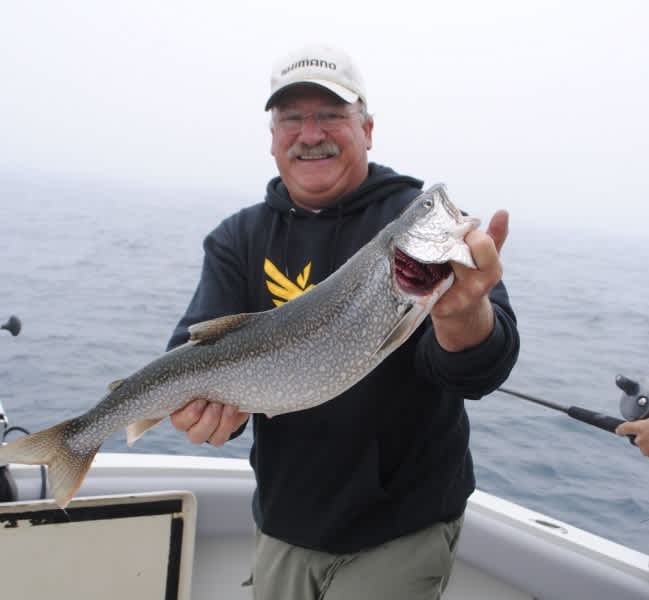Lake Michigan Charter Boat Fishing is as Fun as Ever
Bob Gwizdz 06.29.15

Fishing on Lake Michigan (which is under the microscope now because of significant questions about the alewife population) is better than some think, says charter boat skipper Dave Engel. But it’s different.
Engle says he’s been catching 17 to 20 fish a trip pretty regularly. But a lot of them are lake trout.
And there’s the rub. After three or four decades of reasonably consistent salmon fishing, lake trout seem to some like the bobby prize.
Not so, says Engel.
“Nobody wants to catch trout,” he said, “until they’ve ridden around for two hours and not had a bite.”
Having fished with Engel for a couple of decades now, I know that he’s not only an excellent fisherman, but he’s always shown more respect to lake trout than a lot of guys. Lakers, he says, are unfairly tarred.
“They’re great table fare,” he said the other day as we braved choppy seas aboard his 36-foot Tiara Best Chance Too. “They’re a cold-water fish. All cold-water fish are good; people love whitefish. People love burbot. There aren’t very many cold-water fish that aren’t good eating.”
Lakers are “better eating than they used to be,” he continued. “It’s orange meat, not pale like they were when they were on an alewife diet. Their main diet now is gobies. So they’re not only providing a fishery, they’re helping the other species out.”
Engel, who’s been in the charter business for more than 30 years, says lakers provided a charter boat fishery before salmon and did so during other lean times for kings.
“We’ve always had good trout fishing here,” he said. “You always need them when the salmon disappear, which they always do, sometime during the year. Trout smooth out the slow spots.
“We caught a lot of trout last year, too, but we always have. The same thing happened with BKD (bacterial kidney disease) back in the ‘90s. Thank goodness the DNR stuck to its plans for a multi-species fishery.”
Back when the Chinooks were really cooking, lots of folks suggested the Department of Natural Resources get out of stocking all the other salmonids—as kings were bigger and more spectacular—and concentrate its effort on Chinooks. But the DNR maintained it wasn’t good policy to put the whole bankroll on one roll of the dice. It appears they had a point.
Lake trout are different than other salmon as they tend to hug the bottom more, though they can be caught up in the water column, too.
“When they’re eating alewives, they’re up in the water column,” Engel said. “We’ve won tournaments by catching lakers 150 feet down in 300 feet of water in the past. They were full of lake chubs. Of course, we know what happened there.”
Indeed, the chubs are gone.
Engel was running about 15 lines, the usual assortment of downriggers, diving planers and copper lines off planer boards—he’s given up lead-core and gone entirely to copper—and a lot of them were down near bottom. He had a number of baits on the business ends that guys have traditionally used for lakers.
For instance, we took one nice lake trout on a Sutton Spoon (a big, heavy, brass spoon that went out of style 30 years ago). “Used to be you couldn’t catch a lake trout without one,” Engel said.
Engel also ran a lot of Spin-N-Glos, buoyant-bodied baits with plastic or Mylar wings, behind attractors.

“You have to be very attentive to your equipment when you fish for lake trout,” said Engel as he and his mate, Eric Schippa, were constantly adjusting the depths of the downriggers and the lengths of the copper lines.
“SpIn-N-Glos work well because they float up when your attractor is bumping bottom. You want that thing ticking the bottom once in a while, but not dragging the bottom. It’ll just load up on zebra mussels if you drag bottom.”
It was a tough day as an unexpected north wind seemed to have put the fish off their bite. We had boated three lake trout and missed a couple of others when Lew Wilson, the ramrod of this group of sports, reeled in a 14-pound-class Chinook.
The water temperature was perfect for Chinooks, but the fish didn’t appear to be around. We marked very few fish up in the water column; when the fish locator showed fish, they were down on or near bottom.
But even the lake trout bite was off, which perplexed Engel a little.
“We should have a dozen or 15 fish by now,” Engel said.
So he switched courses and took the Tiara over some humps and rock piles. And we started picking up lake trout again.
All the while the seas, which were tough to begin with, built. By 11 a.m., Wilson said his crew had had about enough. No sense in getting beat up.
We had eight fish in the box—seven of them lake trout. It was fair fishing for four hours; double that count and you’d figure you had a good catch.
“This is the first day this year we didn’t catch a limit of lake trout,” Engel said.
Reports from Lake Michigan have been that it’s been a hit or miss fishery this season. The salmon are here one day, gone the next. It appears the kings, which depend almost entirely on alewives for their food supply, will be a little harder to come by this year than they have been many years.
But that’s fishing, eh? Lake Michigan is an ever-changing environment and the changes we’re seeing right now don’t favor kings.
“But we can always catch trout,” Engel said.
And that’s a good thing.
For more information on Michigan fishing go to michigan.org. Click here to purchase a Michigan fishing license online.
This article was produced in partnership with Pure Michigan.

